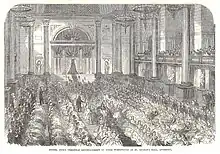 | |
| Industry | Tobacco |
|---|---|
| Founded | 1845 |
| Defunct | 1952 |
| Fate | The company was taken over by Gallaher in 1952 |
| Headquarters | Liverpool, UK |
Key people | Thomas Cope, George Cope |
| Products | Cigarettes, Cigars, Snuff, Tobacco |
Number of employees | 1500 |
Cope Bros & Co was a company based in Liverpool that manufactured tobacco products from 1848 until 1952.[1][2]
History
The company was started in 1848 in Old Post Office Street, Liverpool by Thomas Cope and George Cope[1][3]

In 1853 the business moved to the Old Church for the Blind in Lord Nelson Street, Liverpool.[1][3] The company also obtained buildings and warehouses nearby over the following decades.[3][4] By the 1880s the company was employing nearly 2000 staff and producing multiple brands of snuff, cigars, cigarettes and tobacco. [1] [5] It was estimated that in the late 1800s the company was contributing £400,000 in tax revenues to the Exchequer annually[6]
The Company became public in 1885 [7] following the death of Thomas Cope in 1884. George Cope became the first managing director in 1885,[8] and on his death in 1888 was succeeded by the newspaper-owner John A. Willox.[9]
1904 was one of the company’s worst trading years as tobacco duty was increased.[10]
John Arnold Cope, the son of Thomas, took over the running of the company and retired from the role of managing director in 1948 to become Chairman.[11] He retired completely in 1949 being the last Cope to be involved with the business.[12] The company was taken over by Gallaher in 1952 [2]
Locally
The company employed mainly women and girls[1] and was regarded by local press to be a model employer of the age [1][13][14] with better working conditions than other employers. The company gave cooking lessons to the women [15] and the company was also known to have an annual Soiree and ball that was often reported in local newspapers and other regions newspapers of the time.[16][17][18][19] The factory in Lord Nelson Street Liverpool, and the Copes in particular, were praised for providing favourable working conditions for women by Charles Dickens and Emily Faithfull.[20]


Marketing
Cope's held a leadership position in British advertising. Smoking had been common for centuries but the innovations comprised brand names, heavy advertising, and market segmentation according to class. An innovative appeal was to health consciousness; the ads directed at the middle-class promised that "smoke not only checks disease but preserves the lungs." A rugged heavy taste was pitched to working men, soldiers and sailors, while "delicately fragrant" was part of the appeal to the upper-class. The packaging was attractive, posters were omnipresent to show that smoking was a normal part of English life; lobbying was used to undercut the anti-tobacco lobby.[21]
From 1889 the company produced their own publicity material and literature publishing Cope’s Tobacco Plant and Smoke Room booklets. The literature promoted the company’s products and also smoking in general and was combative in nature to the Anti-Smoking campaigns of the time.[1][22][23] In 1893 John Ruskin took out an injunction against the company to stop them publishing his works in advertising. [24][25] Many of the Cope Bros cigarette cards are still collected, bought and traded on auction web sites such as eBay.
References
- 1 2 3 4 5 6 7 Cope's and the Promotion of Tobacco in Victorian England, by A. V. Seaton, Newcastle upon Tyne Polytechnic
- 1 2 “Gallaher takes over Copes Tobacco”, The Times, Monday, Dec 01, 1952
- 1 2 3 “The Late MR Thomas Cope JP” -Liverpool Mercury (Liverpool, England), Friday, September 19, 1884; Issue 11448
- ↑ “Sold to Thomas Cope” Liverpool Mercury (Liverpool, England), Friday, August 6, 1875
- ↑ Cope Bros letter to the Times. The Times, Monday, Jul 30, 1888
- ↑ Hatton, J., "A Day in a Tobacco Factory", Cope's Smoke Room Booklets, No 14, reprinted from the English Illustrated Magazine, January, 1892,
- ↑ County Gentleman- A Sporting Gazette and Agricultural Journal (London, England), Saturday, October 17, 1885; pg. 1331
- ↑ “Death of George Cope” - The Leeds Mercury (Leeds, England), Saturday, February 4, 1888
- ↑ "Obituary: Sir John Willox". The Times. 17 June 1905. p. 8, col C. Retrieved 9 September 2012.(subscription required)
- ↑ “Cope Bros and Co Limited” - The Times, Tuesday, Aug 23, 1904
- ↑ “Business Changes” - The Times, Monday, May 10, 1948; pg. 7; Issue 51067
- ↑ “Business Changes” - The Times, Thursday, Feb 24, 1949
- ↑ "Local Hives of Industry", Liverpool Citizen, 21 January 1891, p. 6
- ↑ Fun (London, England), Saturday, September 07, 1872
- ↑ Co-operative News 26 August 1876
- ↑ “Annual Ball at Copes” Liverpool Mercury (Liverpool, England), Saturday, January 1, 1859; issue 3394
- ↑ “The Use of St Georges Hall” - Liverpool Mercury (Liverpool, England), Saturday, October 17, 1863
- ↑ “Annual Ball Cope’s Cigar Factory” - North Wales Chronicle (Bangor, Wales), Saturday, January 8, 1859
- ↑ “Cope Brothers Christmas Eve” - Lloyd's Weekly Newspaper (London, England), Sunday, January 13, 1867
- ↑ The Times, Saturday, Sep 20, 1884; pg. 9; Issue 31244; col F Obituary
- ↑ A. V. Seaton,"Cope's and the Promotion of Tobacco in Victorian England." European Journal of Marketing (1986) 20#9 pp: 5-26.
- ↑ Cope's Smoke Room Booklets, Nos. 1-14, 1889-93
- ↑ “Do You Smoke it” Fun (London, England), Saturday, February 11, 1871
- ↑ The Pall Mall Gazette (London, England), Saturday, November 25, 1893
- ↑ RUSKIN v. COPE BROTHERS & CO., LIMITED The Belfast News-Letter (Belfast, Ireland), Monday, November 27, 1893
Further reading
- Hilton, Matthew (2000). Smoking in British popular culture, 1800-2000: perfect pleasures. Manchester University Press. ISBN 978-0-7190-5257-6.
- Seaton, A. V. "Cope's and the Promotion of Tobacco in Victorian England." European Journal of Marketing (1986) 20#9 pp: 5-26.
